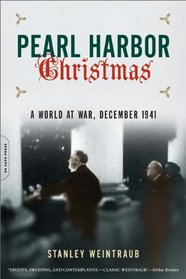After establishing the scene with the Prelude chapter (Churchill enroute to D.C., etc.), the author offers a day by day diary of December 22, 1941 to January 1, 1942 centered on the White House as the war was organized. Sample, 22 December 1941:
"At the White House at 10:00 A.M., Stimson proposed that a Joint Southeast Pacific command base be built up 'sufficiently far back to be unmolested,' suggesting an area beyond likely seizure by the Japanese. Without mentioning Australia, it was clearly the site he had in mind. (Hoping for a more hands-on role for himself, Churchill had proposed instead a 'Central Governing Body in Washington' to direct action in the Far East.) Marshall, Stimson, and Arnold all objected to Washington because of the time lag that distance would create. In Arnold's words, 'Twenty-four hours would be too late.'
Churchill, although tipped off by Hopkins, professed surprise at the suggestion of Wavell as joint commander. Roosevelt also proposed MacArthur--if available--although FDR conceded that no American had sufficient war experience to be 'suitable for the post.' Arnold offered to 'get MacArthur out of the Philippines' if he were the choice. Pride, however, dictated that MacArthur would remain where he was, as he refused to accept from his isolation on Corregidor that he had already lost the Philippines. Ignoring the news from beyond the Rock, about which he knew only by radio, he chose to believe encouraging if unrealistic resupply rhetoric from Marshall and Roosevelt and expected reinforcements to press through the Pacific and repel Japanese seaborne forces blocking shipping lanes toward Luzon. Assistance was indeed on the way--but slowly and obliquely and inadequately. Most of it would stop in Australia and remain there."
There is a paragraph or two discussing sources for each chapter, appropriate but not well printed illustrations, bibliography, and index.
"At the White House at 10:00 A.M., Stimson proposed that a Joint Southeast Pacific command base be built up 'sufficiently far back to be unmolested,' suggesting an area beyond likely seizure by the Japanese. Without mentioning Australia, it was clearly the site he had in mind. (Hoping for a more hands-on role for himself, Churchill had proposed instead a 'Central Governing Body in Washington' to direct action in the Far East.) Marshall, Stimson, and Arnold all objected to Washington because of the time lag that distance would create. In Arnold's words, 'Twenty-four hours would be too late.'
Churchill, although tipped off by Hopkins, professed surprise at the suggestion of Wavell as joint commander. Roosevelt also proposed MacArthur--if available--although FDR conceded that no American had sufficient war experience to be 'suitable for the post.' Arnold offered to 'get MacArthur out of the Philippines' if he were the choice. Pride, however, dictated that MacArthur would remain where he was, as he refused to accept from his isolation on Corregidor that he had already lost the Philippines. Ignoring the news from beyond the Rock, about which he knew only by radio, he chose to believe encouraging if unrealistic resupply rhetoric from Marshall and Roosevelt and expected reinforcements to press through the Pacific and repel Japanese seaborne forces blocking shipping lanes toward Luzon. Assistance was indeed on the way--but slowly and obliquely and inadequately. Most of it would stop in Australia and remain there."
There is a paragraph or two discussing sources for each chapter, appropriate but not well printed illustrations, bibliography, and index.




